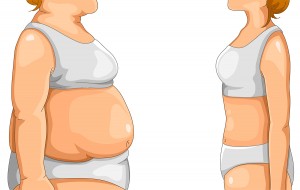Introduction
In the first place, here I am discussing causes of cancer of the uterus. It is important to realize that in the U.S. there are 35,000 women who are diagnosed with a new case of cancer of the uterus every year. In fact, in the same year 4,500 women die of the disease.
Certainly, these statistics have not changed over the last decade. For one thing, the peak age group for women who develop uterine cancer is age 55 to 60. Notably, only about 5% of cases are reported in women below the age of 40 (data from Ref. 1 and 2). To clarify, this table (data from Ref. 1, page 1195 and 1196) may need some explanation:
Until recently these factors were simply noted as an increased risk. They were not thought to be related to each other. Recent eicosanoid research, however, found the missing link (Ref. 3, page 144).
Factors associated with increased risk of uterine cancer
| obesity | estrogen secreting ovarian tumor |
| late menopause | unopposed estrogen pills or injections |
| never had a baby | syndrome of insulin resistance |
| polycystic ovaries | hypertension |
| diabetes | arthritis |
| hypothyroidism | rare genetic syndromes (moderate risk) |
It must be remembered that one of the culprits is a high insulin level. That is to say that all of the conditions from the table are in some way related to the syndrome of insulin resistance or “syndrome X”. These were the names physicians used in the past. Now it has been renamed as “metabolic syndrome”. The metabolic syndrome consists of the combination of obesity, polycystic ovary syndrome, diabetes, and hypertension. High insulin levels can cause many forms of arthritis due to “bad eicosanoids” (for further details see Ref. 3). As Dr. Sears, the inventor of the zone diet, stated the following: “bad eicosanoids that increase insulin secretion are the same ones that increase the likelihood of heart disease, cancer, and arthritis” (Ref. 3, page 144). Moreover, a Swedish study (Ref.4) confirmed that there is a high risk of uterine cancer in patients with diabetes, hypertension and obesity.
“The ‘bad eicosanoids’ that increase insulin secretion are the same ones that increase the likelihood of heart disease, cancer, and arthritis.” (Dr. Sears, Ref. 3, page 144).
Unopposed estrogen leads to increased risk of uterine cancer
Equally important is unopposed estrogen exposure of the endometrial lining of the uterus. This can lead to an increased risk of uterine cancer. Such is the case with a late menopause, or if she never had a baby, an estrogen secreting tumor and unopposed estrogen as pills or injections. On the other hand, the birth control pill was shown to cut the risk for uterine cancer to about 70% to 80% compared to a woman who does not use hormone pills or injections. With this in mind, it is estrogen production from the ovaries, which is blocked when outside hormones are given. This is even true when women take modified estrogen or progesterone molecules as with synthetic hormone products. The same reasoning what is true for the BCP holds true for postmenopausal hormone replacement, which is usually known under “ERT” meaning “estrogen replacement therapy”.
Estrogen dominance
For many years physicians paid attention specifically to estrogen, because a lack of estrogen causes a postmenopausal woman get hot flushes and vaginal dryness. However, when researchers reported increased uterine cancer rates in the medical literature, the started more research. This showed that a birth-control pill like combination of small amounts of additional progestin (like Provera) with estrogen rendered the estrogen risk neutral or similar to the birth control pill. At the same time the physician still must watch the side-effects of too much progestin, which in general leads to clotting problems including strokes. Indeed, this came out from the Women’s Health Initiative (Ref. 13). As a result of these developments we now know that certainly only bio-identical hormones should be given for hormone replacement (HRT). Bioidentical hormones in the proper mix reduces the risk for uterine cancer, breast cancer and colon cancer.
Genetic risks for uterine cancer development
Finally there are some rarer cases of genetic traits in certain families where there is a moderate risk of increased uterine cancer rates. For more info on uterine cancer click on “Cancer Of The Uterus” under “Related Topics” below.
References
1. Cancer: Principles &Practice of Oncology.4th edition. Edited by Vincent T. DeVita, Jr. et al. Lippincott, Philadelphia,PA, 1993. Vol. 1. Chapter on gynecological tumors.
2. Cancer: Principles&Practice of Oncology. 5th edition, volume 1. Edited by Vincent T. DeVita, Jr. et al. Lippincott-Raven Publ., Philadelphia,PA, 1997. Chapter on gynecological tumors.
3. B. Sears: “The age-free zone”. Regan Books, Harper Collins, 2000.
4. E Weiderpass et al. Cancer Causes Control 2000 Feb;11(2):185-192.
5. S Shibutani et al. Cancer Res 2001 May 15;61(10):3925-3931.
6. DB Fournier et al. Gynecol Oncol 2001 Jun;81(3):366-372.
7. DS McMeekin et al. Gynecol Oncol 2001 May;81(2):273-278.
8. LA Katz et al. Am J Obstet Gynecol 2001 May;184(6):1071-1073.
9. B Bonanni et al. Breast J 2000 Oct;6(5):317-323.
10. MG Jain et al. Eur J Epidemiol 2000;16(10):899-905.
11. Conn’s Current Therapy 2004, 56th ed., Copyright © 2004 Elsevier
12. Ferri: Ferri’s Clinical Advisor: Instant Diagnosis and Treatment, 2004 ed., Copyright © 2004 Mosby, Inc
13. Writing Group for the Women’s Health Initiative Investigators: Risks and benefits of estrogen plus progestin in healthy postmenopausal women. Principal results from the Women’s Health Initiative randomized controlled trial. JAMA 2002;288:321-333.







